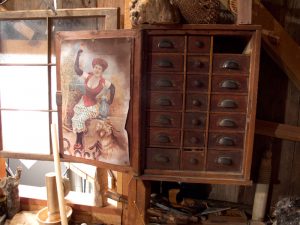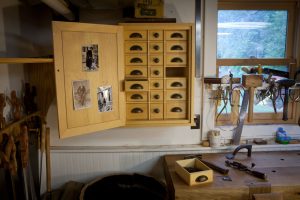We may receive a commission when you use our affiliate links. However, this does not impact our recommendations.
After setting up shop with your workbench and tool chest (or cabinet), the next project to build for your shop is a nail cabinet – a traditional way to hold fasteners and all the little bits of hardware woodworkers accumulate.
Nail cabinets were a common feature of early shops, whether you built furniture or shod horses. And this year I got to reproduce the cabinet from Roy Underhill’s “The Woodwright’s Shop” show.
Roy had purchased the cabinet years ago at a Washington, D.C., yard sale and it has hung out behind him in every program since the beginning of the show. It’s chock full of nails, slotted screws and other shop detritus. That’s not surprising. What is surprising is that Underhill’s nail cabinet is made from an old crate from the Ohio Match Co.
So when I reproduced the cabinet, I got to first build a crate, and then transform it into a nail cabinet with 21 drawers. While the cabinet looks like a lot of work with all the little drawers, it actually is quick to build. The drawers are built using nails and glue.
You can build one for yourself with a plan in the February 2014 issue of Popular Woodworking Magazine. And here’s the great news: Popular Woodworking is giving away a digital copy of this issue for free. It’s not some sneaky trial offer. You don’t have to give up your e-mail or swab the inside of your mouth to get the issue. Just go here and click to download it.
There’s some other cool stuff in the issue, including an article by Chuck Bender on the wacky but cool Mercer Museum.
— Christopher Schwarz
Here are some supplies and tools we find essential in our everyday work around the shop. We may receive a commission from sales referred by our links; however, we have carefully selected these products for their usefulness and quality.










One thought I had was the the cabinet slid into something else for storage. I’ve seen a fair number of shop built cabinets in which the drawer bottoms extended beyond the drawer sides to act as runners in dados in the outer cabinet sides. Or it could just be an affectation.
Mark
That might be my next shop project. I just finished dovetailing six drawers for my tool cabinet, and the thought of another 21 drawers has me hesitating… I know nailing them will be faster than dovetailing. The upside is the it’s another 21 chances to make “drawer” jokes with my wife.
I can’t help thinking that the egg crate dividers should fit into dados in the case. I may have have to tweak the design a bit if I make this.
One good thing about this project, for beginners, is that you can tackle learning handcut dovetails and even if you do screw it up, no one will know because they’re covered!
Nice project, Chris! I just finished putting my shop together and storage was on my mind! This couldn’t have come at a better time!
Hi Chris,
I have an old crate I’m going to use for this project so the measurements will be different. However, I noticed in the exploded view that the dividers were 6″ wide/deep and the drawers are 8 1/2″ deep but with the drawers installed they do not stick out beyond the dividers. In the photo showing the dividers going together they look a lot more like 8″+ than 6″ but I may have simply missed something in reading the article. (My wife says I read for speed not accuracy.)
I have a good collection of Tremont nails ready to fill the drawers so thanks for this and all the other great articles.
Dick
Chris, enjoyed your appearance on Roy’s show yesterday. I’ve never seen you use your “Test Nickles” before. Are they new? Too, I was wondering if Megan had any?
V/r
dpaul
I thought this was a great issue. Besides the articles you mention I particularly enjoyed Jeff Miller’s article on the appliance for cutting accurate tenon shoulders. Last May at the Handworks show in Iowa I was very impressed by how simple the idea was and how accurate it was. I also liked George Walker’s and Bob Flexner’s articles a lot too. Acetone is one of the solvents I use a lot so I was interested in finding out more about it.
That nail cabinet is on my todo list since it looks pretty simple and I’m tired of searching through all the jars and boxes for nails or screws when I need them. I like the idea of labeling the drawers. I have yet to read the lowboy article but it looks interesting. All in all an excellent issue. As usual.
Jim